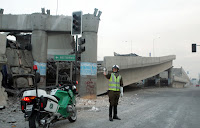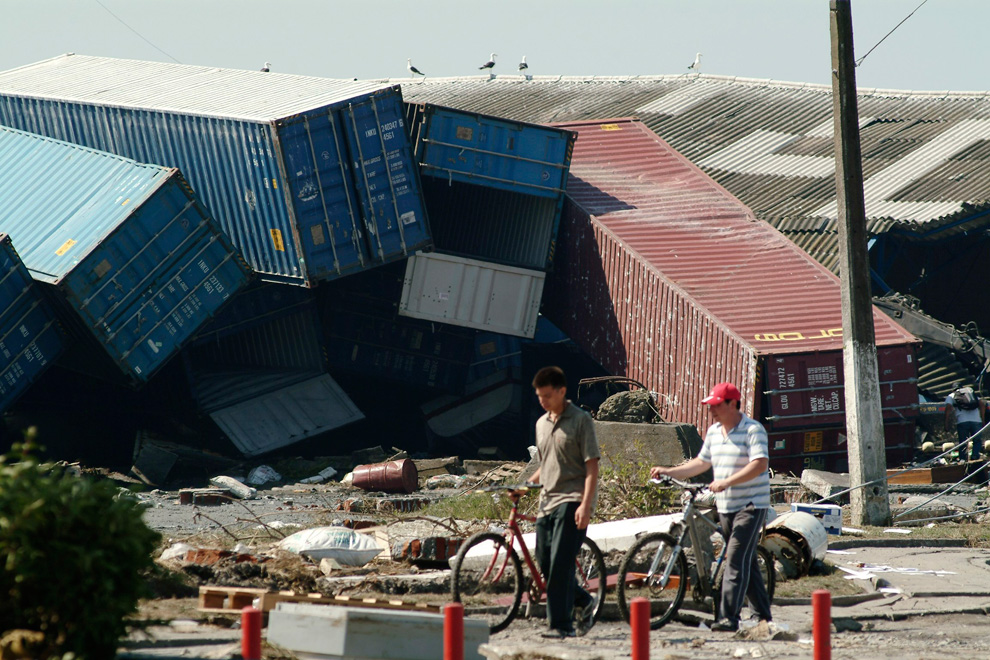The notion of reconstruction is complex and involves careful planning of the stages that will comprise at least immediate emergency solutions and then permanent reconstruction. Planning involves a thorough knowledge of the areas in questions. The staging needs to be conceived in a manner that facilitates a smooth transition from one stage of the process to the next. Unfortunately this is not easy to achieve and as I saw in Managua, Nicaragua almost three decades after the earthquake, inappropriate planning can later prevent the implementation of permanent appropriate solutions. For instance, I am referring to one of the many cases in which a “temporary” market solution became a permanent ill conceived feature, which determined most of what later developed around. Reconstruction in some of the poorest regions of the world carries the danger that emergency solutions will become permanent features and we need to be aware of this.
 Container solution for Haiti. Image source: Inhabitat [1] |  Collapsed infrastructure in Santiago, Chile. Image source: AP Photo/David Lillo |
Planning entails the big picture which is tied to cultural, social, economic, political, heritage, geographic and climate aspects. Furthermore, as we have seen in Chile (27 Feb. 2010, one of the strongest earthquakes ever recorded, 8.8 magnitude)—-where large numbers of psychologists, social workers and university students mobilised to the affected areas to support those people traumatised by the disaster—reconstruction also involves careful and long term consideration of the needs of those who were directly or indirectly affected by the disaster.
The point of this quick outline on reconstruction is to provide the context where architecture might play a positive role as part of a much large strategy.
When looking at some of the architectural solutions proposed in response to natural or man-made disasters, I wonder whether architects, authors of some of these proposals, have ever experienced or visited and engaged with people in need anywhere, including their own countries. If not, have they studied what reconstruction is really about? In view of their own sense of the importance of their architectural contributions, it may not be possible for them to consider that perhaps consultation is a good way to go about. Thus the following questions could be posed by others: who should decide what is to be done? Are there other reasons behind the apparent altruistic architectural works? Do the people designing for others consider the geography, climate, the social and economic conditions for which they are designing? Are local citizens and among them their own professionals better positioned to design and decide on the terms of their own reconstruction?
Designers have the power to make things worse as much as better, and are most effective for good when operating within a context prescribed by their abilities and influence. If there was a genuine programme to help Haiti, it would have been initiated years ago, in concert with an organisation with the resources to carry out a focused, effective (and therefore probably small-scale) intervention. It might have saved a few dozen lives. But architects were too busy drawing houses on stilts in the Lower Ninth Ward of New Orleans.[2]
These questions emerge once more after having seen too many stylistically focused and at many levels inadequate (design, cultural and cost terms) proposals for the Victorian bushfires reconstruction (Australia) and a similar abysmal number of inapt architectural “solutions” proposed for earthquake affected areas in Haiti and Chile. Note that the same container solution was suggested for Chile and Haiti (countries diametrically opposed in almost every single aspect)—a solution tested earlier with Bosnian refugees.[3]
In the fantasy world of some architects and the architectural media that promotes them, their misplaced dreams make them unable to distinguish between different climatic, economic and cultural conditions. People from all different parts of the world, under the spell of these architectural creations, supported by a great deal of imagery, can make those affected by a disaster appear as if strolling along the beach (refer to this link and image below).
 |
| Image used here to illustrate the point of "fantasy" when dealing with reconstruction. Source: Green Container International Aid |
Many of these solutions are insensitive to populations' needs and to cultural differences, as they depart from the belief that one architectural idea fits all (the not very creative container idea for instance). Many of these solutions are also insensitive and “globally” ignorant of the diverse climatic conditions, seismic and economic conditions. For instance, to lock the containers in place in some of the most seismic regions of the world, the recycled container would need such an expensive and robust structural system that the structure alone could provide other more suitable and purposely designed housing solutions. As claimed by one of the many container emergency solutions designers, the containers housing worked well in Bosnia, but even if that was the case, wars and earthquakes are not the same thing.[4]
 |
| "Children walk past shipping containers washed up by a wave caused by an earthquake in Talcahuano Port, a city just outside Concepcion," Chile on February 27, 2010. (REUTERS/Jose Luis Saavedra) |
Have any of these designers ever investigated local building codes and solutions? For instance, here is an article on la “Villa Portales”, a large social housing development built between 1955 y 1967 in Santiago Chile, which suffered no damage after the 2010, 8.8 magnitude earthquake. Local solutions such as the "mediaguas", have for many decades served as emergency housing in Chile—these are also sustainable and provide insulation from the very cold winters of Santiago. These 'mediaguas' are minimal and do not display “sexy” rococo or postmodern frills. They do the job while responding to local conditions, using local materials and labour—they are simply temporary emergency housing.
Much care is given to the positioning of these houses in a layout that resembles a neighbourhood and that can foster conviviality while maintaining the privacy of their occupants. This important work was not prompted by the earthquake. This work is supported by years of experimentation and testing and it represents one of the many examples from which architects willing to engage in reconstruction could learn from.
 Image source: RedArquitectura |
The combination of disaster and creative designers’ arrogance makes for a dangerous mix. Dangerous because the efforts are misplaced, so are the economic resources destined to reconstruction and worst of all, the perpetuation of unawareness and disregard for the accumulated local professional knowledge and the knowledge of those affected—characteristics that continue to pervade much of these reconstruction efforts.
Let’s “call a spade a spade”. While it is not my intention to upset any of these designers, it is on the other hand important to ‘mature’ as a profession, to step out of this egocentric and infantile state that allows some to uncritically present his/her fantasies to people who need real solutions. Perhaps only then, when we can critically assess these solutions and see beyond the imagery that invariably accompanies them, we will have a chance to contribute to and with the rest of the world. For now I propose that we interrogate these proposals to understand what is to be done if we are to engage with the real world at all.
Below I have pasted some links that can give the reader a glimpse of the issues here discussed.
Proposed solutions and discussions:
• Green Container International AID
• Puerto Rico 'Haha…bitat'
• Architectural responses to the Haitian earthquake reveal misplaced motives.
• Is Haiti a Laboratory for New Urbanists? What the Country Really Needs Is Old Urbanism | Aerotropoli
Articles on the earthquake in Chile:
• “Why did fewer die in Chile's earthquake than in Haiti's?”. BBC News, 1 March 2010.
• “Un Techo para Chile construirá 30 mil viviendas para damnificados por terremoto”. El Mercurio. 3 March 2010.
• Frank Bajak. “Chile was ready for quake, Haiti wasn’t”. Associated Press (AP), 27 February 2010.
• Sebastian Gray. “Santiago Stands Firm”. New York Times, 2 March 2010.
• “Ministra de Vivienda llama a propietarios a acogerse a Ley de Calidad por daños” (Minister call home owner to find protection for damages to their properties in the ‘Law of Quality’). El Mercurio, 3 March 2010.
• Beatriz Maturana. “Notes on the Earthquake in Chile”. Architects for Peace, 8 March 2010.
Author: Beatriz C. Maturana
The author would like to thank and acknowledge colleagues from ReCUA (Caribbean Network of Urbanism and Architecture) for the rigorous and stimulating conversations on many of these topics.
Notes
[1] Two days after this article was published, the post published in Inhabitat which this link refers to has been removed. A reference to this post, which includes some images, can still be found here (10.04.10): http://sigalonenvironment.soup.io/tag/Disaster-proof%20design; now (24.05.10) is back again: here
[2] Baldwin, Ian. "Architectural responses to the Haitian earthquake reveal misplaced motives." Custom Home Online (1 March 2010, originally published in Architectural Review), http://www.customhomeonline.com/industry-news.asp?sectionID=275&articleID=1225348.
[3]+ [4] Since publishing this article, the webpage displaying one of the container solutions which I have referred to, has changed its content (http://green-container-intl-aid.com/home). It now (10.04.10) includes detailed information about the structural system that supports the containers.
* This article was updated on 10.04.2010

















